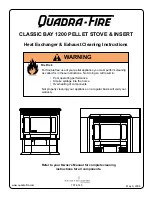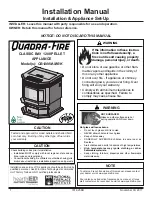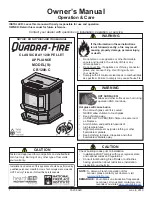
Osburn 1600 Installation and Operation Manual
26 ______________________________________________________________________________
5.2
CHIMNEY AND CHIMNEY CONNECTOR MAINTENANCE
5.2.1
WHY CHIMNEY CLEANING IS NECESSARY
Wood smoke can condense inside the chimney connector and chimney, forming a combustible
deposit called creosote. If creosote is allowed to build up in the venting system it can ignite when a
hot fire is burned in the stove and a very hot fire can progress to the top of the chimney. Severe
chimney fires can damage even the best chimneys. Smouldering, smoky fires can quickly cause a
thick layer of creosote to form. When you avoid smouldering so the exhaust from the chimney is
mostly clear, creosote builds up more slowly. Your new stove has the right characteristics to help
you to burn clean fires with little or no smoke, resulting in less creosote in the chimney.
5.2.2
HOW OFTEN SHOULD YOU CLEAN THE CHIMNEY?
It is not possible to predict how much or how quickly creosote will form in your chimney. It is
important, therefore, to check the build-up in your chimney monthly when getting used to the
new stove until you determine the rate of creosote formation. Even if creosote forms slowly in
your system, the chimney should be cleaned and inspected at least once each year.
It is recommended to clean thoroughly the chimney system at the end of every heating season.
During summer, the air is damper and with minimal air circulation within the stove or furnace, it
can mix with creosote and/or sooth deposits in the chimney system to form an acid that could
accelerate the corrosion process and induce premature decay of the steel. Corrosion damages are
not covered under warranty. Have your chimney system cleaned by a professional chimney sweep.
Use a plastic or steel brush.
Contact your local municipal or provincial fire authority for information on how to handle a
chimney fire. Have a clearly understood plan to handle a chimney fire.
















































